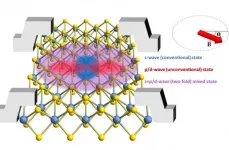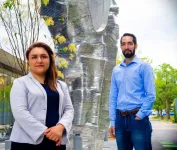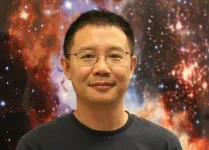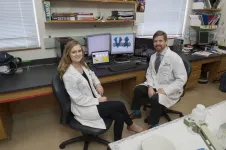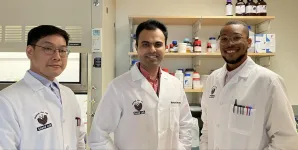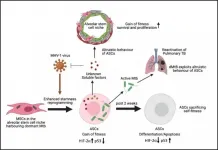(Press-News.org) An international team of physicists led by the University of Minnesota has discovered that a unique superconducting metal is more resilient when used as a very thin layer. The research is the first step toward a larger goal of understanding unconventional superconducting states in materials, which could possibly be used in quantum computing in the future.
The collaboration includes four faculty members in the University of Minnesota's School of Physics and Astronomy--Associate Professor Vlad Pribiag, Professor Rafael Fernandes, and Assistant Professors Fiona Burnell and Ke Wang--along with physicists at Cornell University and several other institutions. The study is published in Nature Physics, a monthly, peer-reviewed scientific journal published by the Nature Research.
Niobium diselenide (NbSe2) is a superconducting metal, meaning that it can conduct electricity, or transport electrons from one atom to another, with no resistance. It is not uncommon for materials to behave differently when they are at a very small size, but NbSe2 has potentially beneficial properties. The researchers found that the material in 2D form (a very thin substrate only a few atomic layers thick) is a more resilient superconductor because it has a two-fold symmetry, which is very different from thicker samples of the same material.
Motivated by Fernandes and Burnell's theoretical prediction of exotic superconductivity in this 2D material, Pribiag and Wang started to investigate atomically-thin 2D superconducting devices.
"We expected it to have a six-fold rotational pattern, like a snowflake." Wang said. "Despite the six-fold structure, it only showed two-fold behavior in the experiment."
"This was one of the first times [this phenomenon] was seen in a real material," Pribiag said.
The researchers attributed the newly-discovered two-fold rotational symmetry of the superconducting state in NbSe2 to the mixing between two closely competing types of superconductivity, namely the conventional s-wave type--typical of bulk NbSe2--and an unconventional d- or p-type mechanism that emerges in few-layer NbSe2. The two types of superconductivity have very similar energies in this system. Because of this, they interact and compete with each other.
Pribiag and Wang said they later became aware that physicists at Cornell University were reviewing the same physics using a different experimental technique, namely quantum tunneling measurements. They decided to combine their results with the Cornell research and publish a comprehensive study.
Burnell, Pribiag, and Wang plan to build on these initial results to further investigate the properties of atomically thin NbSe2 in combination with other exotic 2D materials, which could ultimately lead to the use of unconventional superconducting states, such as topological superconductivity, to build quantum computers.
"What we want is a completely flat interface on the atomic scale," Pribiag said. "We believe this system will be able to give us a better platform to study materials to use them for quantum computing applications."
In addition to Pribiag, Fernandes, Burnell, Wang, the collaboration included University of Minnesota physics graduate students Alex Hamill, Brett Heischmidt, Daniel Shaffer, Kan-Ting Tsai, and Xi Zhang; Cornell University faculty members Jie Shan and Kin Fai Mak and graduate student Egon Sohn; Helmuth Berger and László Forró, researchers at Ecole Polytechnique Fédérale de Lausanne in Switzerland; Alexey Suslov, a researcher at the National High Magnetic Field Laboratory in Tallahassee, Fla.; and Xiaoxiang Xi, a professor at Nanjing University in China.
The University of Minnesota research was supported primarily by the National Science Foundation (NSF) through the University of Minnesota Materials Research Science and Engineering Center (MRSEC). The research at Cornell was supported by the Office of Naval Research (ONR) and NSF. The work in Switzerland was supported by the Swiss National Science Foundation.
INFORMATION:
Clinical research on COVID-19 has boomed in the 18 months since the disease first appeared. Countless papers have looked at the topic from almost every possible angle, including methods of detection.
For a new paper published in the journal END ...
RIVERSIDE, Calif. -- Supermassive black holes, or SMBHs, are black holes with masses that are several million to billion times the mass of our sun. The Milky Way hosts an SMBH with mass a few million times the solar mass. Surprisingly, astrophysical observations show that SMBHs already existed when the universe was very young. For example, a billion solar mass black holes are found when the universe was just 6% of its current age, 13.7 billion years. How do these SMBHs in the early universe originate?
A team led by a theoretical physicist at the University of California, Riverside, has come up with an explanation: a massive seed black hole that the collapse of a dark matter halo could produce.
Dark matter halo is the halo of invisible matter ...
RESEARCH TRIANGLE PARK, N.C. -- A new approach to studying conjugated polymers made it possible for an Army-funded research team to measure, for the first time, the individual molecules' mechanical and kinetic properties during polymerization reaction. The insights gained could lead to more flexible and robust soft electronic materials, such as health monitors and soft robotics.
Conjugated polymers are essentially clusters of molecules strung along a backbone that can conduct electrons and absorb light. This makes them a perfect fit for creating soft optoelectronics, such as wearable electronic devices; however, as flexible as they are, these polymers are difficult to study in bulk because they aggregate ...
DALLAS (SMU) -- A team of SMU biological scientists has confirmed that P-glycoprotein (P-gp) has the ability to remove a toxin from the brain that is associated with Alzheimer's disease.
The finding could lead to new treatments for the disease that affects nearly 6 million Americans. It was that hope that motivated lead researchers James W. McCormick and Lauren Ammerman to pursue the research as SMU graduate students after they both lost a grandmother to the disease while at SMU.
In the Alzheimer's brain, abnormal levels of amyloid-β proteins clump together to form plaques that collect between neurons and can disrupt cell function. ...
Why can some people weather the stress of social isolation better than others, and what implications does this have for their health? New research from the Communication Neuroscience Lab at the Annenberg School for Communication at the University of Pennsylvania found that people who felt a strong sense of purpose in life were less lonely during the COVID-19 pandemic. Did they achieve less loneliness by flouting public health guidance? No. Although lonelier people were less likely to want to follow public health guidance, people with a stronger sense of purpose also expressed more willingness to engage in social distancing, hand washing, and other ...
A new study looking at the way human cells activate the immune system in response to SARS-CoV-2 infection could open the door to even more effective and powerful vaccines against the coronavirus and its rapidly emerging variants keeping the global pandemic smoldering.
Researchers from Boston University's National Emerging Infectious Diseases Laboratories (NEIDL) and the Broad Institute of MIT and Harvard say it's the first real look at exactly what types of "red flags" the human body uses to enlist the help of T cells--killers sent out by the immune system to destroy infected cells. Until now, COVID vaccines have been focused on activating a different type of immune cell, B cells, which are responsible for creating antibodies. Developing vaccines to activate ...
Steroid (sex) hormones play a central role in sexual development: They help determine how boys become boys and girls become girls. If these hormones are disrupted during fetal life, it can lead to a string of reproductive disorders at birth and later in life, including malformed genitals and decreased fertility.
Many environmental chemicals are known to disrupt the hormone system and are often referred to as endocrine disrupting chemicals. Azole fungicides constitute one group that can act as endocrine disruptors. Azoles are used to combat yeast infestations in seed and food crops, but are also used in medications for humans.
Most azoles used in medicines are tightly regulated and their use is well controlled. However, some are sold over-the-counter, for ...
Philadelphia, June 16, 2021 - The SARS-CoV-2 virus that causes COVID-19 may have the ability to reactivate dormant tuberculosis (TB). In a novel study scientists END ...
In a new publication from Cardiovascular Innovations and Applications; DOI https://doi.org/10.15212/CVIA.2021.0011, Xiao-lei Yin, Dong-xue Liang, Lu Wang, Jing Qiu, Zhi-yun Yang, Jian-zeng Dong and Zhao-yuan Ma from Tsinghua University, Beijing, China; Capital Medical University, Beijing, China and The First Affiliated Hospital of Zhengzhou University, Zhengzhou, China analyse coronary angiography video interpolation methods to reduce x-ray exposure frequency based on deep learning.
Cardiac coronary angiography is a major technique that assists physicians during interventional heart surgery. Under X-ray irradiation, the physician ...
In a new publication from Cardiovascular Innovations and Applications; DOI https://doi.org/10.15212/CVIA.2021.0013, Sharen Lee, Gary Tse, Xin Wang, Adrian Baranchuk and Tong Liu from Laboratory of Cardiovascular Physiology, Hong Kong, China, Second Hospital of Tianjin Medical University, Tianjin, China and Queen's University, Kingston, Ontario, Canada consider ST-segment depression in leads I and aVL.
The 12-lead electrocardiogram (ECG) is a routinely performed test but is susceptible to misinterpretation even by experienced physicians. The authors report a case of a 72-year-old lady with no prior cardiac history presenting with atypical chest pain. Her initial electrocardiogram shows an initial ST depression followed by positive deflections leads I and aVL. ...
